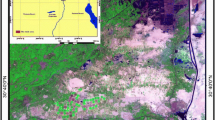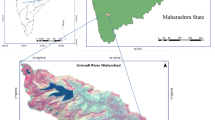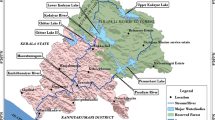Abstract
Land quality assessment is of great important for decisions on sustainable land uses and the conservation of ecosystems of high biodiversity value. The main objective of this study was to determine properties of land quality of specially protected area of the Salt Lake using CORINE land quality assessment methodology and to propose a revision for this model. In addition to field study and laboratory analysis, digital soil map, digital elevation model, satellite image and climatic data were used and analyzed with remote sensing and geographic information systems techniques to generate actual land quality map and to form database for study area. Results show that 42.1% of the study area has high quality, 28.7% was classified as moderate quality and 4.0% was determined as low quality. On the other hand, some places classified as moderate quality, were not accurately classified. These places should be low land quality due to content of high salt concentration. Therefore, to resolve this insufficient situation, some soil parameters such as chemical properties should be collaborated with this model. In this case, moderate land quality level of the study area decreased from 28.7 to 12.3%, whereas 4.0% of low quality land of the study area increased to 20.8%. In addition, this research was also carried out to provide guidance for planner or decision makers about specially protected area of the Salt Lake.
Similar content being viewed by others
References
Aronoffon, S. (1989). Geographic information system: A management perspective. Ottawa, ON, Canada: WLD Publ.
Bouma, J. (2002). Land quality indicators of sustainable land management. Agriculture Ecosystems and Environment, 88, 129–136.
Brejda, J. J., Moorman, T. B., Karlen, D. L., & Dao, T. H. (2000). Identification of regional soil quality factors and indicators: I. Central and southern high-plains. Soil Science Society of America Journal, 64, 2115–2124.
Campbell, J. B. (1987). Introduction to remote sensing. New York: The Guilford Press.
Chan, K. Y., Bowman, A., & Oates, A. (2001). Oxidizible organic-carbon fractions and soil quality changes in an oxic Paleustalf under different pasture leys. Soil Science, 166, 61–67.
Commission of the European Communities (1985). Soil map of the European communities, Luxembourg.
Commission of the European Communities (1990). Official journal of the European Communities, L 81, Luxembourg.
CORINE (1992). CORINE soil erosion risk and important land resources. Luxembourg: Commission of the European Communities.
Duclos, G. (1980). Appréciation de l'aptitude à la mise en Valeur Forestière et Agricole des Zones Accidentées de Provence’, Forêt Méditerranéenne Vol. 11, No 1.
Green, K. (1995). Using GIS to predict fire behaviour. Journal of Forestry, 93, 21–25.
Hinton, J. C. (1996). GIS and RS integration for environmental applications. International Journal of Geographical Information Science, 10, 877–890.
Lake-Tuz (http://en.wikipedia.org/wiki/Lake_Tuz), last update 2001.
Larson, W. E., & Pierce, F. J. (1991). Conservation and enhancement of soil quality. Evaluation for sustainable land management in the developing world. Vol. 2. IBSRAM Proc. 12 (2). Bangkok, Thailand. Int. Board Soil Res. Manage., Bangkok, Thailand pp. 175–203.
Pennock, D. J., Anderson, D. W., & de Jong, E. (1994). Landscapes-scale change in indicators of soil quality due to cultivation in Saskatchewan, Canada. Geoderma, 64, 1–19.
Pieri, C., Dumanski, J., Hamblin, A., & Young, A. (1995). Land quality indicators. World Bank Discussion Papers 315. Washington: World Bank.
Rodolfi, G. (1986). Criteri di Conservazione del Suolo per l’incremento Della Produttività Agricola Nelle Aree Marginali Appenniniche Desunti da Un'analisi Pedo-Geomorfologica di Dettaglio, Nota Preliminare (con esemplicificazione cartografica), in Annali dell’Istituto Sperimentale di Studio e Difesa del Suolo (Firenze), vol. 17.
Schipper, L. A., & Sparling, G. P. (2000). Performance of soil condition indicators across taxonomic groups and land uses. Soil Science Society of America Journal, 64, 300–311.
Seybold, C. A., Mausbach, M. J., Karlen, D. L., & Rogers, H. H. (1997). Quantification of soil quantity. In R. Lar, et al. (Ed.) Soil processes and the carbon cycle (pp. 387–404). Boca Raton, FL: CRC.
Soil Survey Staff (1999). Soil taxonomy. A basic of soil classification for making and interpreting soil survey. USDA Handbook No: 436, Washington, DC.
Southorn, N., & Cattle, S. (2000). Monitoring soil quality for central tablelands grazing systems. Communications in Soil Science and Plant Analysis, 31, 2211–2229.
TNT (1999). TNT (The New Thing) MIPS (MicroImage Processing System), getting started geospatial analysis, MicroImages, USA.
Wander, M. M., & Bollero, G. A. (1999). Soil quality assessment of tillage impacts in Illinois. Soil Science Society of America Journal, 63, 961–971.
Wang, X., & Gong, Z. (1998). Assessment and analysis of soil quality changes after eleven years of reclamation in subtropical China. Geoderma, 81, 339–355.
Webb, K. T., Wang, C., Astatkie, T., & Langille, D. R. (2000). Spatial and temporal trends in soil properties at a soil quality benchmark site in central Nova-Scotia. Canadian Journal of Soil Science, 80, 567–575.
Yassoglou, N., Nychas, A., Apostolakis, G., & Kosmas, C. (1983). Soil survey report of Argos plain, Larissa, Ministry of Agriculture, Soil Survey Institute.
Author information
Authors and Affiliations
Corresponding author
Rights and permissions
About this article
Cite this article
Dengiz, O., Baskan, O. Land quality assessment and sustainable land use in Salt Lake (Tuz Gölü) specially protected area. Environ Monit Assess 148, 233–243 (2009). https://doi.org/10.1007/s10661-008-0154-4
Received:
Accepted:
Published:
Issue Date:
DOI: https://doi.org/10.1007/s10661-008-0154-4




